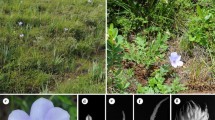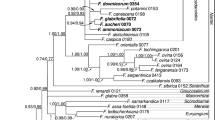Abstract
Nomocharis aperta (Franchet) E. Wilson is a heterogeneous species including morphotypes with pink tepals bearing swellings on both sides of the inner tepal’s basal median channel and those with yellow tepals lacking swellings. Molecular phylogenetic and pair-wise distance analyses of nrITS and chloroplast psbA-trnH support recognition of the yellow-flowered morphotype lacking nectary processes as a new, separate species of Nomocharis. Here, we present the new species, Nomocharis gongshanensis Y. D. Gao et X. J. He sp. nov., and resolve its systematic position in the Lilium–Nomocharis complex using the ITS and psbA-trnH markers. Seven variant copies of ITS were isolated from N. gongshanensis. Maximum parsimony and Bayesian analyses placed the clones in two different Nomocharis clades, N. aperta + N. saluenensis and sect. Eunomocharis, suggesting a putative hybrid origin of the new species. The psbA-trnH sequence of N. gongshanensis is identical to that of N. saluenensis, indicating that the latter may be the maternal ancestor. Our analyses support the monophyly of Lilium–Nomocharis and mutual paraphyly of the two genera. Nomocharis was resolved within Lilium as sister to the European lilies of sect. Liriotypus (sensu İkinci). The 12 Lilium–Nomocharis clades recovered in this study are consistent with previous molecular studies but are incongruent with traditional circumscription of and subgeneric divisions within Lilium. These results highlight the need for taxonomic revision of Lilium to accommodate Nomocharis and reconsideration of the origin and evolution of Nomocharis.



Similar content being viewed by others
References
Akaike H (1974) A new look at the statistical model identification. IEEE T Automat Contr 19:716–723
Baker JG (1871) A new synopsis of all the known lilies. Gard Chron 104:1650
Balfour B (1918) The genus Nomocharis. Bot J Scot 27:273–300
Baranova MV (1988) A synopsis of the system of the genus Lilium (Liliaceae). Bot Zurn 73:1319–1329
Brock RD (1954) Fertility in Lilium hybrids. Heredity 8:409–420
Chen FB (1992) Hengduan event: an important tectonic event of the late Cenozoic in Eastern Asia. Mt Res 10:195–202
Chen FB (1996) Second discussion on the Hengduan movement. Volcanol Miner Resour 17:14–22
Chung SL, Lo CH, Lee TY, Zhang YQ, Xie YW, Li XH, Wang KL, Wang PL (1998) Diachronous uplift of the Tibetan plateau starting 40 Myr ago. Nature 394:769–773
Comber HF (1949) A new classification of genus Lilium. R Hort Soc Lily Year Book 13:85
Doyle JJ, Doyle JL (1987) A rapid DNA isolation procedure for small quantities of fresh leaf tissue. Phytochem Bull 19:11–15
Dubouzet JD, Shinoda K (1999) Phylogenetic analysis of the internal transcribed spacer region of Japanese Lilium species. Theor Appl Genet 98:954–960
Evans WE (1925) A revision of the genus Nomocharis. Notes Roy Bot Gard Edinb 15:1–46
Fay MF, Chase MW, Rønsted N et al (2006) Phylogenetics of Liliales: summarized evidence from combined analyses of five plastid and one mitochondrial loci. In: Columbus JT, Friar EA, Porter JM, Prince LM, Simpson MG (eds) Monocots: comparative biology and evolution (excluding Poales). Rancho Santa Ana Botanic Garden, Claremont, CA, pp 559–565
Franchet AR (1889) Nomocharis Franchet. J Bot (Morot) 3:113
Funk DJ, Omland KE (2003) Species-level paraphyly and polyphyly: frequency, cause and consequences, with insights from animal mitochondrial DNA. Annu Rev Ecol Evol S 34:397–423
Hamilton MB (1999) Four primer pairs for the amplification of chloroplast intergenic regions with intraspecific variation. Mol Ecol 8:521–523
Harrison TM, Copeland P, Kidd WSF, Yin A (1992) Raising Tibet. Science 255:1663–1670
Haw SG (1986) The lilies of China. Timber Press, Portland
Hayashi K, Kawano S (2000) Molecular systematics of Lilium and allied genera (Liliaceae): phylogenetic relationships among Lilium and related genera based on the rbcL and matK gene sequence data. Plant Spec Biol 15:73–93
Holder MT, Lewis PO (2003) Phylogeny estimation: traditional and Bayesian approaches. Nat Rev Gene 4:275–284
Holderegger R, Abbott RJ (2003) Phylogeography of the Arctic-Alpine Saxifraga oppositifolia (Saxifragaceae) and some related taxa based on cpDNA and ITS sequence variation. Am J Bot 90:931–936
İkinci N, Oberprieler C, Güner A (2006) On the origin of European lilies: phylogenetic analysis of Lilium section Liriotypus (Liliaceae) using sequences of the nuclear ribosomal transcribed spacers. Willdenowia 36:647–656
Kress WJ, Erickson DL (2007) A two-locus global DNA barcode for land plants: the coding rbcL gene complements the non-coding psbA-trnH spacer region. PLoS One 6:e508
Kress WJ, Wurdack KJ, Zimmer EA, Weight LA, Janzen DH (2005) Use of DNA barcodes to identify flowering plants. Proc Natl Acad Sci U S A 102:8369–8374
Kumar S, Tamura K, Nei M (1993) MEGA: Molecular Evolutionary Genetics Analysis, version 1.01. The Pennsylvania State University, University Park, PA. http://evolgen.biol.metro-u.ac.jp/MEGA/manual/default.html. Accessed 8 Aug 2011
Lahaye R, van der Bank M, Bogarin D, Warner J, Pupulin F, Gigot G, Maurin O, Duthoit S, Barraclough TG, Savolainen V (2008) DNA barcoding the floras of biodiversity hotspots. Proc Natl Acad Sci U S A 105:2923–2928
Liang SY (1980) Flora Reipublicae Popularis Sinicae, vol. 14, Anagiospermae, Monocotyledoneae Liliaceae (I). Science Press, Beijing, pp 116–157
Liang SY (1984) Studies on the genus Nomocharis (Liliaceae). Bull Bot Res 4:163–178
Liang SY (1995) Chorology of Liliaceae (S. Str.) and its bearing on the Chinese Flora. Acta Phytotax Sin 33:27–51
Liang SY, Tamura M (2000) Lilium L.; Nomocahris Franchet. In: Wu ZY, Raven PH (eds) Flora of China, vol 24. Science Press, Beijing; Missouri Botanical Garden Press, St. Louis, pp 135–159
Liang SY, Zhang WX (1985) Pollen morphology of the genus Nomocharis and its delimitation with Lilium. Acta Phytotax Sin 23:405–417
Liu JQ, Wang YJ, Wang AL, Hideakic O, Abbott RJ (2006) Radiation and diversification within the Ligularia–Cremanthodium–Parasenecio complex (Asteraceae) triggered by uplift of the Qinghai-Tibetan Plateau. Mol Phylogenet Evol 38:31–49
McRae EA (1998) Lilies: a guide for growers and collectors. Timber Press, Portland, pp 17–26
Morrell PL, Rieseberg LH (1998) Molecular tests of the proposed diploid hybrid origin of Gilia achilleifolia (Polemoniaceae). Am J Bot 85:1439–1453
Morrison DA (2009) A framework for phylogenetic sequence alignment. Plant Syst Evol 282:127–149
Newmaster SG, Ragupathy S (2009) Testing plant barcoding in a sister species complex of pantropical Acacia (Mimosoideae, Fabaceae). Mol Ecol Res 9(Suppl 1):172–180
Nishikawa T, Okazaki K, Uchino T, Arakawa K, Nagamine T (1999) A molecular phylogeny of Lilium in the internal transcribed spacer region. J Mol Evol 49:238–249
Nishikawa T, Okazaki K, Arakawa K, Nagamine T (2001) Phylogenetic analysis of section Sinomartagon in genus Lilium using sequences of the internal transcribed spacer region in nuclear ribosomal DNA. Breed Sci 51:39–46
Nylander JAA (2004) MrModeltest 2.0. Department of Systematic Zoology, EBC, Uppsala University, Uppsala (available from the author)
Patterson TB, Givnish TJ (2002) Phylogeny, concerted convergence, and phylogenetic niche conservatism in the core Liliales: insights from rbcL and ndhF sequence data. Evolution 56:233–252
Peruzzi L, Leitch IJ, Caparelli KF (2009) Chromosome diversity and evolution in Liliaceae. Ann Bot (Oxford) 103:459–475
Rambaut A, Drummond AJ (2007) Tracer v1.4. http://beast.bio.ed.ac.uk/Tracer. Accessed 5 Aug 2011
Rešetnik I, Liber Z, Satovic Z, Cigić P, Nikolić T (2007) Molecular phylogeny and systematics of the Lilium carniolicum group (Liliaceae) based on nuclear ITS sequences. Plant Syst Evol 265:45–58
Ronquist F, Huelsenbeck JP (2003) MrBayes 3: bayesian phylogenetic inference under mixed models. Bioinformatics 19:1572–1574
Rønsted N, Law S, Thornton H, Fay MF, Chase MW (2005) Molecular phylogenetic evidence for the monophyly of Fritillaria and Lilium (Liliaceae; Liliales) and the infrageneric classification of Fritillaria. Mol Phylogenet Evol 35:509–527
Royden LH, Burchfiel BC, Van der Hilst RD (2008) The geological evolution of the Tibetan Plateau. Science 321:1054–1058
Sang T, Crawford DJ, Stuessy TF (1997) Chloroplast DNA phylogeny, reticulate evolution, and biogeography of Paeonia (Paeoniaceae). Am J Bot 84:1120–1136
Sass C, Little DP, Stevenson DW, Specht CD (2007) DNA barcoding in the cycadales: testing the potential of proposed barcoding markers for species identification of cycads. PLoS ONE 2:e1154
Sealy JR (1950) Nomocharis and Lilium. Kew Bull 5:273–297
Sealy JR (1978) Nomocharis pardanthina Franchet f. punctulata Sealy. Notes Roy Bot Gard Edinb 36:295
Sealy JR (1983) A revision of the genus Nomocharis Franchet. Bot J Linn Soc 87:285–323
Shaw J, Lickey EB, Schilling EE, Small RL (2007) Comparison of whole chloroplast genomes to choose non-coding regions for phylogenetic studies in angiosperms: the tortoise and the hare III. Am J Bot 94:275–288
Siripun KC, Schilling EE (2006) Molecular confirmation of the hybrid origin of Eupatorium godfreyanum (Asteraceae). Am J Bot 93:319–325
Song J, Yao H, Li Y, Li X, Lin Y, Liu C, Han J, Xie C, Chen S (2009) Authentication of the family Polygonaceae in Chinese pharmacopoeia by DNA barcoding technique. J Ethnopharmacol 124:434–439
Swofford DL (2003) PAUP*. Phylogenetic analysis using parsimony (*and Other Methods). Version 4. Sinauer Associates, Sunderland, MA
Tamura MN, Yamashita J, Fuse S, Haraguchi M (2004) Molecular phylogeny of monocotyledons inferred from combined analysis of plastid matK and rbcL gene sequences. J Plant Res 117:109–120
Tamura K, Dudley J, Nei M, Kumar S (2007) MEGA4: molecular evolutionary genetics analysis (MEGA) software version 4.0. Mol Biol Evol 24:1596–1599
Thompson JD, Gibson TJ, Plewniak F, Jeanmougin F, Higgins DG (1997) The CLUSTAL_X Windows interface: flexible strategies for multiple sequence alignment aided by quality analysis tools. Nucleic Acids Res 25:4876–4882
Trewick SA (2008) DNA barcoding is not enough: mismatch of taxonomy and genealogy in New Zealand grasshoppers (Orthoptera: Acrididae). Cladistics 24:240–254
Tuyl JM, Van Diën MP, Van Creij MGM, Van Kleinwee TCM, Franken J (1991) Application of in vitro pollination, ovary culture, ovule culture and embryo rescue for overcoming incongruity barriers in interspecific Lilium crosses. Plant Sci 74:115–126
Vinnersten A, Bremer K (2001) Age and biogeography of major clades in Liliales. Am J Bot 88:1695–1703
Vischi M, Arzenton F, De Paoli E, Paselli S, Tomat E, Olivieri AM (2006) Identification of wild species of sunflower by a specific plastid DNA sequence. Helia 29:11–18
Wang FZ, Tang J (1980) Lilium L. In: Flora Reipublicae Popularis Sinicae, vol 14. Science Press, Beijing, pp 116–157
White TJ, Bruns T, Lee S, Taylor J (1990) Amplification and direct sequencing of fungal ribosomal RNA genes for phylogenetics. In: Innis MA, Gelfand DH, Shinsky JJ, White TJ (eds) PCR protocols: a guide to methods and applications. Academic Press, San Diego, pp 315–322
Wilson EH (1925) The Lilies of Eastern Asia: a monograph. Dulau, London
Xie XY, Gu ZJ, Wu QA (1992) Cytological studies of the genus Nomocharis and its related genera. Acta Phytotax Sin 30:487–497
Yao H, Song JY, Ma XY, Liu C, Li Y, Xu HX, Han JP, Duan LS, Chen SL (2009) Identification of Dendrobium species by a candidate DNA barcode sequence: the chloroplast psbA-trnH intergenic region. Planta Med 75:667–669
Zhang DF, Li FQ, Bian JM (2000) Eco-environmental effects of the Qinghai-Tibet Plateau uplift during the Quaternary in China. Environ Geol 39:1352–1358
Zhang JM, Wang JX, Xia T, Zhou SL (2009) DNA barcoding: species delimitation in tree peonies. Sci China Ser C 52:568–578
Zhang YH, Volis S, Sun H (2010) Chloroplast phylogeny and phylogeography of Stellera chamaejasme on the Qinghai-Tibet Plateau and in adjacent regions. Mol Phylogenet Evol 57:1162–1172
Acknowledgments
The authors thank anonymous reviewers and Professor Jie-mei Xu for valuable suggestions on improvement of the manuscript as well as Hai-feng Wang at the Graduate University of the Chinese Academy of Sciences for assistance with obtaining primary literature sources. This work was supported by the National Natural Science Foundation of China (31100161), the Doctoral Fund of the Ministry of Education of China (20090181110064), the Basic Research Program from the Ministry of Science and Technology of China (grant no. 2007FY110100), and the Research Fund for the Large-scale Scientific Facilities of the Chinese Academy of Sciences (2009-LSF-GBOWS-01).
Author information
Authors and Affiliations
Corresponding author
Electronic supplementary material
Below is the link to the electronic supplementary material.
Rights and permissions
About this article
Cite this article
Gao, YD., Hohenegger, M., Harris, A. et al. A new species in the genus Nomocharis Franchet (Liliaceae): evidence that brings the genus Nomocharis into Lilium . Plant Syst Evol 298, 69–85 (2012). https://doi.org/10.1007/s00606-011-0524-1
Received:
Accepted:
Published:
Issue Date:
DOI: https://doi.org/10.1007/s00606-011-0524-1




